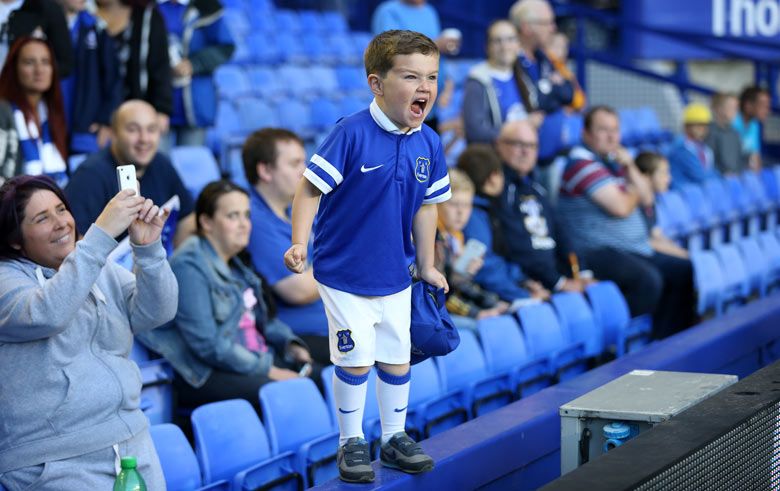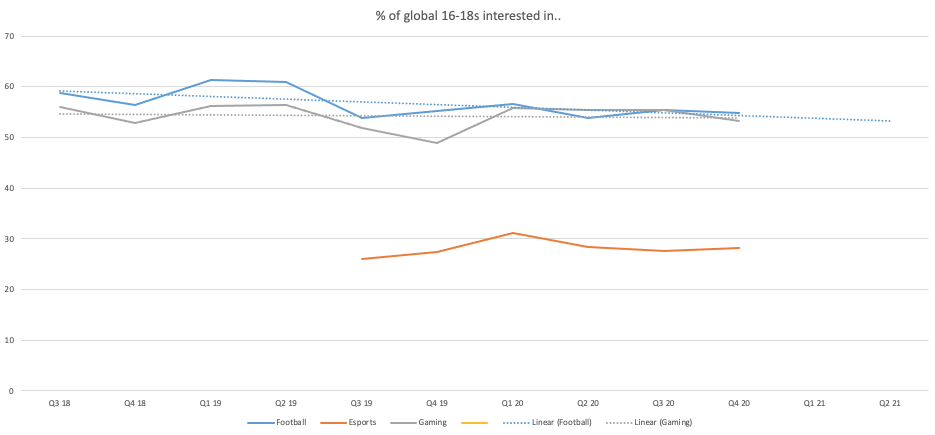© The Fan Experience Company 2020

So What Exactly Is A Future Fan?
On the same day as the ESL project bit the dust (at least for now), the PGA Tour launched its Player Impact Program in which an extra $40m bonus pool will be shared out among the players who “move the needle” the most in terms of social media impact and brand recognition (but not directly related to their performance on the course).
This is, at least in part, a reaction to the proposed Premier Golf League – a kind of ESL for golf that wanted to lure the best players away from the traditional tours.
Both these things are predicated on the idea that sports need to do things differently to engage (and ultimately monetise) young, global and social-media obsessed ‘future fans’.
But who are these fans and what do we know about them? I’ve looked at GWI data for three groups: 16-18s, 19-21s and 22-24s to get a shapshot.
Football is undeniably the global sport, with 55-60% of 16-24s following it in some way. It’s not a surprise to see basketball and UFC also doing well with this age group, but I am surprised to see cycling and swimming up there (these numbers don’t include participation in the sport). Golf, by the way, is down at 6-9% for 16-24s – I wrote about this a few weeks ago.
Which sports do you follow, watch on TV or watch online?
The football stat makes the alleged “young people aren’t interested in football” quote from ESL Chairman Florentino Perez look pretty silly, but I suspect what he meant was that young people are slowly becoming less interested in it. Is this true?
Football is really the only sport that holds up well against other interests for this age group – it’s behind music but on a par with gaming, for the 16-18s. However, interest in football does look to be declining as the audience gets younger, and 16-18s are less likely than the general population to follow football – not a good sign.
Which of these things are you interested in?
But, when we look at that 16-18 interest in football over the last few years, it’s fairly stable. A slight downward trend, but nothing dramatic. Football holds up well compared to gaming, and still well ahead of sports.

Generally speaking, there is a pretty solid level of interest among 16-24s in playing and watching sport, so the foundations are there for individual sports to build on, if they can find the right ways to do it.
The big events and leagues still grab a decent amount of 16-24 attention globally and there is possibly a point here about scarcity if we look at the top three, which only happen every four years). Again we see that downward age trend in most cases.
Which of these events do you follow/have an interest in?
It’s interesting that only 16% of 16-18s follow the Premier League vs. 26% for the NBA. I guess that’s a result of the global football audience being split between five or six major club competitions. When we look at an individual team level, the big football clubs easily outperform NBA teams (Chelsea is more popular globally than the LA Lakers for 16-24s…)
The assumption out there is that these young people are constantly on social media, glued to their phones, obsessed by individual influencers and never watch traditional TV. Hence sport needs to become much more about on-demand, social clips, highlights and individual stars. Is this true?
Well, it’s no surprise that young people are light users of linear TV: 51% of 16-18s watch < 1 hour per day and 16-24s are way more likely than the average person to watch none at all.
What might be surprising is that most of them aren’t spending much time watching streaming TV, either: 66% of 16-18s watch < 1 hour per day.
Daily time spent watching online/streaming TV
16-24s are much more likely than the average person to spend 6+ hours a day online on their phones, but overall they are not glued to them all day long: 57% of 16-18s spend less than four hours a day on a smartphone, and the other 40% worry about spending too much time on them.
It’s a similar picture on social media. There is a cohort of very heavy users, but 46% of 16-18s are on social media for under 2 hours per day. Interestingly, the 16-18s are slightly more likely than the older groups to not use social media at all.
Daily time spent on social media
It’s similar with music streaming: 16-24s are more likely than average to be heavy users, but 70% of 16-18s listen for < 2 hours per day. Gaming is the same – there is a small percentage of very heavy users, but most are <1 hour per day, and overall usage really isn’t that different to older age groups.
When we look at the type of accounts followed on social media, sport is popular (around 25%) but lags quite far behind other interests, although sport does perform better among males when we segment by gender. The caveat to this is that many sports stars do have huge followings and Cristiano Ronaldo is the most followed person in the world on Instagram, but only he and Messi represent sport in the top 10, so 20-25% feels about right.
Type of accounts followed on social media
There are some interesting concerns around social media and technology for this age group. 35-40% worry that they spend too much time on their phones and on social media, with concerns also about control of personal data. Only 36% feel that social media is good for society.
So that’s a snapshot of this young ‘future fan’ audience. Clearly there will be big variations in this data and more meaningful insights to be had by looking at specific regions, countries, gender, income levels, sports etc… but what might this tell us for any rights holder or brand looking to engage this young audience in sport?
These are a few broad themes that jump out at me:
- Young people are still interested in sport, but look for ways to align with music, gaming, technology and film to cement that and engage more of them
- Linear TV is on the way out, but don’t assume 16-24s are glued to their phones and social media all day long – a few are, but mostly it’s a similar pattern to older age groups
- Be sensitive to concerns about the over-use of social media, and online privacy
- Be innovative, but don’t make changes to a sport that risk totally alienating the core fans and/or tearing up the basic fabric of the sport itself (that should be obvs but you never know…)
If any rights holders or brands would like to take a deeper dive into the data and use these insights to develop a strategy for engaging fans, drop me a line.
Original article 26.04.21 on the Overdog Marketing website. Written by Eddie May
To view the original article click here
